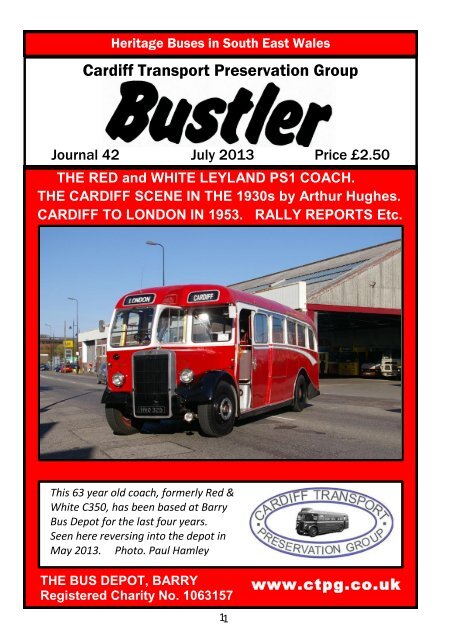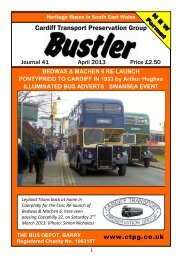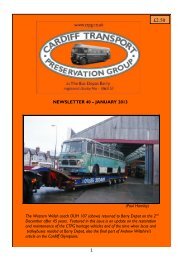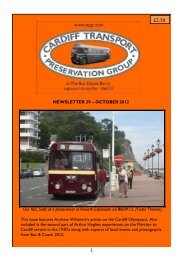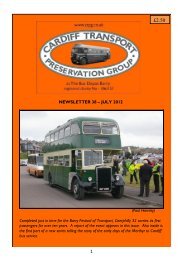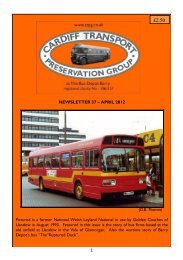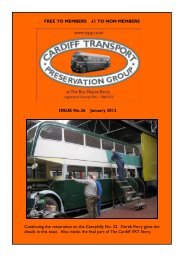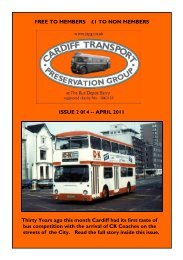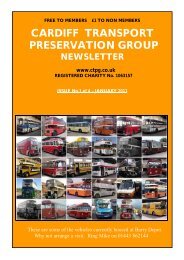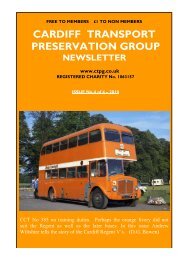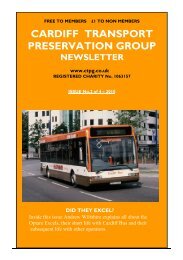Create successful ePaper yourself
Turn your PDF publications into a flip-book with our unique Google optimized e-Paper software.
Heritage Buses in South East Wales<br />
Cardiff Transport Preservation Group<br />
Journal 42 July <strong>2013</strong> Price £2.50<br />
THE RED and WHITE LEYLAND PS1 COACH.<br />
THE CARDIFF SCENE IN THE 1930s by Arthur Hughes.<br />
CARDIFF TO LONDON IN 1953. RALLY REPORTS Etc.<br />
This 63 year old coach, formerly Red &<br />
White C350, has been based at Barry<br />
Bus Depot for the last four years.<br />
Seen here reversing into the depot in<br />
May <strong>2013</strong>. Photo. Paul Hamley<br />
THE BUS DEPOT, BARRY<br />
Registered Charity No. 1063157<br />
1<br />
www.ctpg.co.uk
Buses <strong>of</strong> all shapes, sizes and colours at our May <strong>2013</strong> Municipal Running Day. (P.H./M.E.)<br />
2
CHAIRMAN’S MESSAGE<br />
This year’s events so far have been blessed with good weather, the three so far have<br />
remained dry. On May bank holiday we had our first Municipal Running Day based<br />
purely at the Depot. Several visiting buses attended and ran alongside our collection.<br />
The day was very successful with each bus going out full the open topper with fresh paint<br />
on the new rear panels was very popular. We ran routes to Barry Island, Rhoose and<br />
Dinas/Sully and inside the Depot several stalls were housed and reported good takings.<br />
In June the Barry Festival <strong>of</strong> Transport moved to Barry Island, this was more challenging<br />
in terms <strong>of</strong> the site and distance but again proved to be a huge draw for the public and<br />
enthusiasts alike, obviously assisted by the good weather. The site on the Island was a<br />
bit rough and we filled it quickly but cars were parked on the gardens overlooking the<br />
beach and buses in the lay-bys outside to ensure no one was turned away. The free<br />
buses also ran from the lay-bys and this seemed to work successfully. The VOGC<br />
reported very positive feedback and they are keen to do it again next year with a fully<br />
resurfaced and larger area for the vehicle parking. The rally had its largest attendance <strong>of</strong><br />
visiting stalls which seemed to be doing good trade in fact the CTPG had its best day<br />
financially with the stall and kitchen doing very good trade all day. Well done all those<br />
that helped out although we could have done with a bit more help from some other<br />
members!<br />
Prior to Barry Rally all the CTPG buses requiring an MOT passed, all having been<br />
serviced and checked over including for the first time Western Welsh 177 following its<br />
extensive rebuild at Barry and pr<strong>of</strong>essional repaint at TDC in Lydney. It made its debut<br />
at the Habourside Rally in Bristol late in April. Special praise must go to Martyn Evans<br />
(body) and Paul Burgess (electrics) for getting the coach ready in time, plus the many<br />
hours <strong>of</strong> sanding especially the ro<strong>of</strong> that were undertaken by the rest <strong>of</strong> the Depot<br />
helpers. Attention has now turned to Cardiff 497 with the eventual completion <strong>of</strong> the<br />
repaint long overdue.<br />
So far we have been out on two road runs, Western Welsh 177 performed faultlessly on<br />
a run to Porthcawl and Newport 68 took us on a quick run in June due to a slipping gear<br />
during change into third and fourth, we have two more runs before returning to the<br />
Penarth Conservative club in September. Unfortunately Mike Walker has told me he<br />
cannot perform the August road run this year, so we are looking for another volunteer<br />
vehicle.<br />
Bus & Coach Wales at Merthyr Tydfil Leisure Centre on Sunday 8th September<br />
VOLUNTEERS URGENTLY NEEDED TO HELP AT MERTHYR RALLY<br />
Mike<br />
Tel: 07733 302242<br />
Email : mikeystrad73@btinternet.com<br />
Also keep up to date on our Facebook page<br />
3
A LOOK AT THE TIGER HWO 323;<br />
In the summer <strong>of</strong> 2009 the CTPG became custodian on extended loan <strong>of</strong> the preserved<br />
former Red & White Leyland Tiger PS1 coach. As this bus moves to Gloucestershire for<br />
a few months, this article tells a little <strong>of</strong> its sixty three year history.<br />
The coach was new as No. 23 in the fleet <strong>of</strong> Red & White Services Ltd. <strong>of</strong> Chepstow<br />
and was initially allocated to Brynmawr depot in June 1950. It carried 33 seat coachwork<br />
by Lydney Coachworks, a company associated with Red & White, and was one <strong>of</strong> only<br />
15 <strong>of</strong> this body type built. It was said that the design was an infringement <strong>of</strong> a Duple<br />
pattern. In 1951 the well-known Red & White fleet numbering scheme was introduced<br />
and HWO 323 became C350 (coach No.3 <strong>of</strong> 1950). It was still being used for frontline<br />
express duties even after the introduction <strong>of</strong> the larger capacity under-floor engine<br />
coaches. When in 1959 it was downgraded to bus duties, it became S2050 at<br />
Abergavenny. Withdrawn from service in March 1964 the coach was sold to Western<br />
Welsh, acting as a dealer.<br />
A dream came true for the residents and management <strong>of</strong> the newly opened Danybryn<br />
Cheshire Home at Radyr in November 1964 when they were presented by the Western<br />
Welsh company with the coach specially adapted to carry the disabled on outings etc.<br />
The staff at the Ely Works <strong>of</strong> Western Welsh had agreed to carry out, in their own<br />
time, the complete overhaul and modifications including a hydraulic lift. A Western<br />
Welsh bulletin <strong>of</strong> the time stated that 2150 man/hours were worked by 59 <strong>of</strong> the Ely<br />
employees. The trade too, responded well as all materials were provided free <strong>of</strong> charge.<br />
The coach was painted in a light blue livery similar to the old Lewis & James fleet, a fact<br />
that Mr W.T James (the former M.D.) commented upon.<br />
4
5
Western Welsh drivers also undertook to man the vehicle, again without payment, as<br />
and when required. Employees were also encouraged to make contributions to the<br />
home from their wages.<br />
On the face <strong>of</strong> it, it may seem that the project cost WWOC little, but at the<br />
presentation Mr W.T. James handed over a cheque for £500 to the home, in those days<br />
quite a considerable sum.<br />
After 8 years at Radyr a replacement was required. WWOC provided another<br />
vehicle by again obtaining a bus from Red & White. This was SAX 986, a Bristol<br />
MW/ECW 45 seat saloon, fleet No.U1057. The hydraulic lift was transferred from<br />
HWO to the Bristol. Voluntary work was again provided by WWOC staff at Ely Works<br />
and the vehicle presented to the home in January 1973.<br />
The former Red & White U1057 presented to Danybryn Home in January 1973<br />
After eight years with Danybryn Home, the Bristol MW was sold in January 1981 to the<br />
Radyr Rugby Club. The replacement vehicle at Danybryn Home was KTX 516W, a new<br />
Dodge 50 chassis that carried purpose built bodywork by Thomas Hosking & Sons Ltd.<br />
at Dumballs Road, Cardiff.<br />
Back to HWO 323 which was sold in February 1973 to Red & White enthusiast, Roger<br />
Annetts <strong>of</strong> Parkend. Brian Cox <strong>of</strong> Coleford took it over in the 1980s and it was rallied<br />
for some years with the double doors still attached. Later it appears that a rear section<br />
from a derelict Duple bodied Bedford OB was mated to the rear <strong>of</strong> the Leyland. This<br />
proved successful and looked well.<br />
It was purchased in 1997 by the present owners Martin Bowring and his wife Barbara,<br />
<strong>of</strong> Lydney. Since then a full restoration has been carried out including new upholstery<br />
and trim.<br />
6
Vera Edworthy and the then owner Brian Cox, crewed up for a wedding hire in 1989.<br />
Rear view during preservation in 1989.<br />
7<br />
After 36 years <strong>of</strong> preservation in the<br />
Forest <strong>of</strong> Dean the bus passed into the<br />
care <strong>of</strong> the CTPG in 2009.<br />
Following a MOT test, its first outing<br />
under the CTPG banner was to the<br />
Bristol Vintage Group Running Day at<br />
Brislington in August 2009.<br />
Over the following years the Leyland<br />
was rallied regularly by CTPG with little<br />
trouble apart from a cracked brake<br />
drum.<br />
During the early summer <strong>of</strong> <strong>2013</strong><br />
Martin will be displaying the coach at the<br />
old Red & White bus station at Lydney<br />
and is due to return to Barry later in the<br />
year.<br />
Thanks to Robert Edworthy for<br />
certain information and for the<br />
photographs on this page. Other views<br />
are from the Editor’s collection.
Rear view in its current condition (V.C)<br />
Tours list from Cardiff 1955.<br />
8
MUNICIPAL RUNNING DAY;<br />
On Sunday 5 th May the CTPG <strong>of</strong>fered free heritage bus rides from their Barry Bus<br />
Depot. The gloom <strong>of</strong> the past months suddenly lifted with the arrival <strong>of</strong> warm sunshine<br />
and the crowds came out to see what was going on.<br />
Buses departed every half hour between 10.30 and 16.30 and were restored buses <strong>of</strong><br />
between 30 and 60 years old and were once used by the former south Wales local<br />
councils. These were known as “Municipal Buses” as they were owned by the local<br />
ratepayers. Municipal buses ended in 1986 when councils had to make “arms-length”<br />
companies, such as those today at Cardiff and Newport. The buses operated on this day<br />
represented some <strong>of</strong> these councils including Pontypridd, Caerphilly, Bedwas & Machen,<br />
Islwyn and Rhymney Valley.<br />
The first route was a local journey around the town <strong>of</strong> Barry, visiting the popular<br />
beach area. An hourly circular route was also made either westwards via the Airport<br />
and Aberthaw or eastwards through Dinas Powis and Penarth.<br />
Six <strong>of</strong> the buses used belonged to the CTPG i.e. Ponty 8 (UTG 313G), Newport 68<br />
(EDW 68D), Caerphilly 32 (GNY 432C), Bedwas & Machen 6 (PAX 466F), Cardiff 407<br />
(NDW 407X) and the Cardiff open-topper 434 (ABO 434B).<br />
These were supplemented by Mark Barnett’s IBT 34 (DNY 534V), and Martyn Evans’s<br />
RVDC 16 (YBO 16T). An afternoon duplicate was completed by a 61 year old Leyland<br />
PS1 saloon, Caerphilly 2 (LTX 311) driven by John Wiltshire. Also on display was Wigan<br />
140, the Leyland PD2 <strong>of</strong> Glyn Millington.<br />
The depot was bustling with visitors all day inspecting buses in the process <strong>of</strong> being<br />
restored (or waiting to be) with our volunteers on hand to answer questions.<br />
We heard many appreciative comments on the presentation <strong>of</strong> the vehicles and <strong>of</strong> the<br />
cleanliness <strong>of</strong> the whole depot. This shows that good housekeeping is as important in a<br />
work environment as it is in the home. Mark Hodge, an enthusiast from Merseyside, said<br />
that he wished he had a facility like this nearer his home.<br />
Many visitors made the day <strong>of</strong> it, travelling on the various buses, interspersed with visits<br />
to our canteen. The CTPG stall did particularly well with sales <strong>of</strong> photographs and<br />
books. There were two other stalls also selling transport related items. Even our<br />
neighbour, the “One Stop Shop” benefited from the extra trade.<br />
That the day was such a success was a tribute to all our hardy volunteers who braved<br />
the worst winter for years to bring our fleet up to the standard it is today.<br />
A Good Day!<br />
people smiled!<br />
The sun shone -- the buses ran well -- we made a bob or two -- and<br />
What more could we ask?<br />
9
APRIL MEETING. CHELTENHAM REVISITED; by Peter Heath.<br />
On April 17 th we welcomed back Peter Heath, the Commercial Director <strong>of</strong> Cardiff Bus<br />
to give another illustrated talk..<br />
Peter told <strong>of</strong> his early years in Worcestershire and <strong>of</strong> his visits as a young man to<br />
Cheltenham Coach Station. This iconic location was one <strong>of</strong> the busiest interchange for<br />
coaches in the country and was in use from 1932 to 1984.<br />
Firstly, we were shown photos taken on the August Bank Holiday weekend <strong>of</strong> 1972,<br />
many <strong>of</strong> which were <strong>of</strong> vehicles belonging to the constituent companies <strong>of</strong> Associated<br />
Motorways Ltd. that had been formed in1934. These companies also formed the basis <strong>of</strong><br />
National Express in 1974.<br />
A few hundred yards away from the coach station is Royal Crescent where the local<br />
bus services congregated. Many a Bedford SB were to be seen lined up there in the<br />
1970s and several <strong>of</strong> these belonged to the same independent companies that still<br />
provide bus services to the east and north <strong>of</strong> the town.<br />
A surprise was in store when Peter showed photos <strong>of</strong> a recent trip to Uzbekistan<br />
where gas is much cheaper than oil and all shapes and size <strong>of</strong> bus carried gas cylinders on<br />
their ro<strong>of</strong>. A far cry from genteel Cheltenham!<br />
MAY ROAD RUN;<br />
----------------------------------------<br />
The transport for the<br />
May Road run was<br />
our recently restored<br />
1969 Leyland<br />
Leopard coach OUH<br />
177G, formerly in<br />
the fleet <strong>of</strong> Western<br />
Welsh and the<br />
destination was the<br />
seaside town <strong>of</strong><br />
Porthcawl some 25<br />
miles west <strong>of</strong> Barry.<br />
The coach ran very<br />
smoothly, driven<br />
sensitively by Bob<br />
Sparks. At the depot Bob is usually seen wielding a spanner so it was good to see he had<br />
not lost his talent as a first class driver.<br />
On arrival at our destination many <strong>of</strong> the 25 or so passengers scampered <strong>of</strong>f to visit a<br />
popular watering hole situated alongside the celebrated Porthcawl Pavilion. Others<br />
watched the sun go down over the Bristol Channel or enjoyed the (very) fresh air.<br />
We returned along the A48 and arrived back at the depot at 10pm. It was agreed<br />
that our first road run <strong>of</strong> the year had been most enjoyable. (Photo; Paul Hamley)<br />
10
BOOK REVIEW;<br />
Crosville in Colour 1965-1986, Martin Jenkins and Charles Roberts, 96 pages, Ian<br />
Allan £22.50<br />
What makes for a good day out? What about getting up early, heading down the M4,<br />
passing an ex-Western Welsh Renown on the way and getting to Bristol Harbourside in<br />
time to video the arrival <strong>of</strong> buses and coaches for today's rally? Then having an early ride<br />
on Carl Berry's ex-Crosville RE coach to the Muller Road depot and seeing and filming<br />
the arrival <strong>of</strong> Plaxton-bodied Leopard OUH177G, CTPG's latest addition to its growing<br />
fleet <strong>of</strong> preserved vehicles (congratulations, Martyn!) with quite a number <strong>of</strong> CPTG<br />
members on board?<br />
AFM 103F Carl Berry’s restored RE coach at Muller Road, Bristol 28.4.13<br />
One thing's certain: the day's certainly got <strong>of</strong>f to an excellent start and it gets even better<br />
with a trip on an ex-Bristol Bristol Loddekka out to the Sea Mills turning circle and, later,<br />
a trip on a dual-purpose liveried Bristol L out to Clifton to see the Bridge and the Clifton<br />
Rocks Railway.<br />
And before leaving, what better way to end the day than to pop into the Presbus<br />
stand and pick up the latest in what's become rather a long line <strong>of</strong> books on one <strong>of</strong> the<br />
biggest <strong>of</strong> all the Tilling companies, Crosville?<br />
As some readers may know, the strange fleet numbering system Crosville employed<br />
on its buses was one <strong>of</strong> the main things that aroused my interest in buses in the first<br />
11
place, and the company also has a certain peripheral interest for bus enthusiasts in South<br />
Wales as it once ran service buses in Cardiganshire and a joint express service, with<br />
Western Welsh, to Cardiff. Articles on the joint services to Cardiff, incidentally, appeared<br />
in a couple <strong>of</strong> recent editions <strong>of</strong> the Crosville Enthusiasts' Club monthly Review.<br />
So what <strong>of</strong> the book? It's rather unusual in size and unlikely to sit comfortably in any<br />
row <strong>of</strong> other bus books you may have. The Introduction then appears in print so faint that<br />
you wonder whether your eyesight is going, and some <strong>of</strong> the photographs are rather<br />
mushy, though only the printers and publishers know whether the original photos or the<br />
printing (in Estonia) is to blame.<br />
That said, the photographs are very varied, accurately reflecting the territory in which<br />
Crosville operated. From the seaside at Rhyl to the narrow lanes around Aberystwyth<br />
and on to the mountains around Stwlan Dam, from the suburbia on the Wirral to the<br />
King Street bus station in Wrexham and inside an industrial site in Runcorn, there's<br />
plenty to keep even those not particularly interested in the company entertained.<br />
There's even a snowy scene <strong>of</strong> an RE coach making its way up a hill in Liverpool on hire<br />
to the Merseyside Bus Club shortly before, as the caption sadly records, 'it expired with<br />
transmission failure and is believed never to have run again'. And I can't remember<br />
seeing a photo <strong>of</strong> the back end <strong>of</strong> a row <strong>of</strong> eight FLFs anywhere else.<br />
As with Andrew Wiltshire's books on buses in South Wales, the captions are both<br />
fascinating and plentiful and taught me far more than I'd expected. I hadn't known, for<br />
example, that Crosville's stunning FLF coaches were known to the staff as 'White Ladies'<br />
or that coaches demoted to buses were known as Crabs ('coaches reduced to buses').<br />
As so <strong>of</strong>ten happens, the pictures are just as interesting for their non-bus elements <strong>–</strong><br />
the other traffic, the fashions <strong>of</strong> the day, the long-gone buildings and the street furniture<br />
<strong>of</strong> a long-gone age. The book certainly isn't short <strong>of</strong> those.<br />
Is there anything to interest those with no knowledge <strong>of</strong> bus operations in North<br />
Wales and Merseyside? Yes, there's a photo <strong>of</strong> ex-Red & White flat-fronted Bristol LS<br />
MAX 108, part <strong>of</strong> a saga whereby Croville hired10 Bristol MWs from Red & White for a<br />
year and then replaced them by buying ten Bristol LSs from the same source.<br />
Crosville, as you probably know, swallowed up parts <strong>of</strong> Western Welsh territory, a<br />
process reflected in three photos <strong>of</strong> ex-Western Welsh vehicles that joined the fleet.<br />
Two <strong>of</strong> the photos are particularly interesting in that they show the 'before and after'<br />
effect. In one, there's a sparkling Park Royal-bodied Tiger Cub in Western Welsh's blue<br />
and cream (ivory?) livery while opposite there's a similar vehicle painted in drab and<br />
almost unrelieved (except for the window rubbers) Tilling green. This contrasts with an<br />
earlier photo <strong>of</strong> two <strong>of</strong> the AEC Renowns Crosville took over from the North Western<br />
Road Car Company. In the latter, the drab Tilling Green looks rather better, surprisingly,<br />
than the usually more interesting red and cream livery <strong>of</strong> the NWRCC.<br />
All in all, then, an interesting and enjoyable book but, for those who had no experience <strong>of</strong><br />
Crosville and its operations, rather pricey. Thank goodness the Presbus people did me a<br />
favour by selling it at a discount!<br />
Berwyn Prys Jones<br />
12
THE BARRY FESTIVAL OF TRANSPORT <strong>2013</strong>;<br />
The rally site at Hood Road which we have used for the last nine years is now no longer<br />
available to us and this year the Vale Council <strong>of</strong>fered the CTPG use <strong>of</strong> part <strong>of</strong> the<br />
redevelopment site that was formerly Butlin’s Holiday Camp (later Majestic) at Barry<br />
Island. Work continued by contractors’ right up to the weekend but as the vehicles<br />
arrived on Sunday it was soon clear that the site available would not be big enough.<br />
The Council agreed that some <strong>of</strong> the 200 plus cars could be sited on the Esplanade<br />
Gardens facing the promenade. This was appreciated by the car owners who soon put<br />
out their picnic chairs facing the sea in the sunshine. The main site soon filled up and<br />
some <strong>of</strong> the 50 plus buses were relocated to laybys on the nearby highway.<br />
By 10.30 am vehicle movements on the main site were becoming tricky, especially as<br />
there were private cars using the entrance road to gain access to the council car park.<br />
We really needed all the marshals available to us. The site was a little difficult underfoot<br />
as it was rubble but we are assured that these problems will be resolved in the near<br />
future as the site continues to be developed.<br />
The vintage buses in operation on trips to the depot and also to Rhoose and Penarth<br />
were from the CTPG collection, the Swansea Group and some belonging to private<br />
owners. This year saw three open-toppers in operation, running at full capacity due to<br />
the good weather. The programme sellers had sold out by 11.30am and the stallholders<br />
were doing a steady trade. The weather was probably a little hot to encourage the<br />
public to hang around the rally site especially as there was no ice cream seller.<br />
However, there was an ice cream van at the bus depot that did a good trade, a classic<br />
Mk 1 Transit in fact!<br />
The Barry Tourist Railway was in operation as was the exhibition at the station by the<br />
Barry at War Group which provided some extra interest to visitors. Up at the depot<br />
were more stalls than we have ever had and visitors faced an excellent choice. The sales<br />
<strong>of</strong> refreshments at our depot canteen were also better than expected.<br />
Once again this year we were visited by Jane Hutt AM who is always supportive <strong>of</strong><br />
our events and we welcomed the newly elected Vale Mayor Cllr. Margaret Wilkinson,<br />
her Consort, Cllr. Jayne Norman and Cabinet Member Cllr. Gwyn John.<br />
One could say that the success <strong>of</strong> the event this year was due to the glorious weather,<br />
but really it is thanks to all who came along, the marshals and helpers and the dedication<br />
<strong>of</strong> the restorers <strong>of</strong> the vehicles that appeared on the day. For the CTPG, raising funds<br />
to help with the restoration <strong>of</strong> buses is important and we are pleased with the success <strong>of</strong><br />
this event.<br />
The Vale Council were very pleased with the day and with their support we hope to<br />
repeat the Festival <strong>of</strong> Transport next year maybe with a larger site.<br />
13
THE BARRY FESTIVAL<br />
A view <strong>of</strong> part <strong>of</strong> the Festival site at Barry Island. Buses parked closely due to limited room.<br />
Below: Mike controls the crowds clamouring for the open tops. (Paul Hamley / Viv Corbin)<br />
14
OF TRANSPORT <strong>2013</strong>;<br />
The crowds pile onto RVT 16 and also inspect the numerous stalls at the depot. (Glyn Bowen)<br />
15
JUNE EVENING RUN;<br />
The evening run on June 19 th was a planned visit to the Newport Bus facility at<br />
Corporation Road, Newport. Our transport was the Leyland Mk 11 Atlantean EDW<br />
68D formerly Newport 68. This had been the 2 nd <strong>of</strong> a batch <strong>of</strong> 5 delivered to Newport<br />
after they had tested the Leyland demonstrator KTD 551C in Nov. 1965.<br />
We set <strong>of</strong>f at 7pm but when we reached Cardiff our driver realised the gears were<br />
slipping and as this was happening in 3 rd and 4 th gear it was decided to abort the journey<br />
and return to base. Paul Burgess then coaxed the bus back to Barry via Wenvoe to<br />
avoid most <strong>of</strong> the hills.<br />
We must all remember that we run old buses and that this particular one is 47 years<br />
old. So far we have been very lucky in that there have been very few occasions <strong>of</strong><br />
mechanical malfunctions on our road runs.<br />
We are also fortunate that we have a retired fitter on our Friday team who worked<br />
on these particular transmissions while employed at Western Welsh Ely Works so<br />
hopefully the gearbox bands or valves can be adjusted.<br />
According to a Leyland expert, on the Mk11 Atlantean the original centrifugal clutch<br />
was replaced by a SCG fluid friction clutch. This has a fluid flywheel for starting from<br />
rest and a centrifugal clutch that engages at higher speeds. This was generally more<br />
reliable than the earlier versions, but obviously they were not guaranteed for 47 years!<br />
After alighting at the depot several <strong>of</strong> our members retired to a local hostelry.<br />
As for Newport Bus Depot, we will try again and hope for better luck next time.<br />
Our Newport Atlantean prepares to leave the depot on the June evening run. (Paul Hamley)<br />
16
TO LONDON IN 1953 by V.C.<br />
Yes -- Sixty years ago! As it was Coronation Year I decided to have a week <strong>of</strong> my<br />
holidays in London just a few days after the big event. Having been to the big city several<br />
times before with my parents, this was the first time for me to travel solo.<br />
On a Monday morning, with my father’s warning “Don’t go near Soho” ringing in my<br />
ear, I made my way to Cardiff to catch the 09.30 Red & White coach service to London.<br />
In those days the coaches left<br />
from open ground on the South<br />
side <strong>of</strong> Wood Street.<br />
I was hoping that my coach<br />
would be one <strong>of</strong> the new<br />
under-floor engine models, for<br />
as a youngster I was into<br />
modern vehicles. The 1950s<br />
half cab coaches looked the<br />
same as the pre-war ones to<br />
me then. My luck was in as it<br />
was a new KWO registered<br />
Duple bodied Guy Arab UF.<br />
Off we went and luckily, I sat<br />
next to a girl who I knew from schooldays and when we had a 10 minute break at the<br />
Austral Café at Caerwent, I bought her a c<strong>of</strong>fee, but it turned out she was on her way to<br />
meet her boyfriend at Cheltenham. So no luck there then!<br />
After a 30 minute break at<br />
Cheltenham we changed<br />
coaches to a Black & White<br />
Motorways KDF registered<br />
Willowbrook bodied Royal<br />
Tiger. Along the A40 via<br />
Northleach and Oxford we<br />
went until a 15 minute stop at<br />
the King’s Arms at<br />
Stokenchurch, reaching Victoria<br />
Coach Station at 17.15, some<br />
8¼ hours after leaving Cardiff.<br />
Little did I think then, that 30 years later I would be doing the journey nearly 5 hours<br />
quicker as a driver for National Express.<br />
I stayed with friends <strong>of</strong> my parents at Wembley (so they could keep an eye on me)<br />
and during the next few days I went into the city either on the trolleybus to Edgware<br />
Road or the overground/underground tube train from Stonebridge Park. There were<br />
many distractions for a young lad in London, but I came to see the Queen, and I did see<br />
her -- the real one, not those in Soho!<br />
On the Friday the return journey to Wales was, for some reason I forget, made by<br />
train and hauled by one <strong>of</strong> those “Hall Class” thingies. Not as good as a Royal Tiger!<br />
17
MEMORIES OF THE 1930s PART FOUR by Arthur Hughes;<br />
Readers who have followed Arthur’s recollections will recall that during the 1930s, he travelled<br />
daily from his home in Merthyr Tydfil to his place <strong>of</strong> work in Cardiff. In this article he recalls<br />
some <strong>of</strong> the buses he encountered in the City. Ed. (Photos from the Chris Taylor Collection)<br />
From Whitchurch into the City, more and more Corporation services joined our road,<br />
such as the 24 from Llandaff, 26 Rhiwbina, 28 Llanishen and the 40 from Heathwood<br />
Road and so on. Along what had now become North Road at Gabalfa where to our<br />
left, was the terminus <strong>of</strong> the No.1 tram route. Alongside the tram terminus and<br />
continuing beyond them across North Road, ran bus service 39.<br />
In 1933, the 39 route was exclusively the domain <strong>of</strong> Cardiff’s batch <strong>of</strong> Dennis HS buses<br />
with 48 seat rear entrance, lowbridge bodies by Brush, having the unusual herring bone<br />
seating on the upper deck. Two rows <strong>of</strong> half bucket type seats set back to back, but<br />
with each seat set at an angle <strong>of</strong> 45 degrees so that the passenger was neither fully<br />
looking out <strong>of</strong> the side <strong>of</strong> the bus, nor completely to the front. Two passageways in<br />
front <strong>of</strong> the seats served as access to them, a process which was something <strong>of</strong> an<br />
obstacle race as passengers stumbled over protruding feet giving many a corn a wincing<br />
kick in the process.<br />
In the lower saloon the ro<strong>of</strong> was swept downwards on both sides <strong>of</strong> the central area<br />
considerably more than usually found on lowbridge type bodies. The stairs were a<br />
contortionist’s dream as they incorporated a sharp turn in the middle which combined<br />
with the narrowness <strong>of</strong> the stairs frustrated many a large person to negotiate them.<br />
Though, the Leeds cast <strong>of</strong>fs had even narrower and more awkward stairs in which<br />
people actually got stuck on occasions and had to be helped by the conductor.<br />
(The Leeds cast <strong>of</strong>fs mentioned above were five 1930 Crossley Condors bought for a reported<br />
£50 each by CCT when six years old. Ed.)<br />
In 1929, the new Dennis HS batch took over the original No 1 tram service which<br />
served the same Whitchurch Road terminus, but by a different route and was operated<br />
with single deck cars due to a low bridge at Salisbury Road. These lowbridge buses were<br />
the answer to that problem. Even so, before they were able to operate, the road had to<br />
be lowered some 9 inches which led to flooding in later years.<br />
A further anecdote to this early tram conversion was that CCT had, in 1926/7,<br />
bought 30 new single deck trams, 13 <strong>of</strong> which were required for this service. These<br />
were now redundant and mostly lay dormant in Roath Depot until the early days <strong>of</strong> the<br />
war when they were sold to Brazil.<br />
The cause, if not the logic, <strong>of</strong> this was the appointment in 1929 <strong>of</strong> William Forbes as<br />
Manager <strong>of</strong> Cardiff City Tramways and Motors. He was imported from Aberdeen where<br />
he had introduced minimum fares <strong>of</strong> as low as one old half-penny (where else could this<br />
happen than the Granite City itself ?). There were high hopes <strong>of</strong> something similar<br />
happening for Cardiff’s travelling public. Alas they were not so lucky, and he arrived with<br />
a “scrap the trams in favour <strong>of</strong> buses” policy, which he waited little time in putting into<br />
practice.<br />
18
On the Dennis HS buses, engine power was almost non-existent and the old phrase<br />
about “rice pudding” comes to mind. (They used the same 4 cylinder 50/70hp engine as in<br />
the E type saloons. Ed.)<br />
No. 224, UH 6994, one <strong>of</strong> the Dennis HS buses bought by CCT in 1929.<br />
Luckily, Cardiff had mostly flat terrain, there being only one or two hills worthy <strong>of</strong> the<br />
name within the city limits. One <strong>of</strong> these, named Pen-y-lan, on the 22 City Centre to<br />
Cyncoed service, was a serious inconvenience to the lumbering forward progress <strong>of</strong><br />
these Dennises. This hill was by no means all that stiff, most cars even in those days<br />
were able to get most <strong>of</strong> the way up in top gear, but no matter how heavy the bus<br />
driver’s boot was, after about 250 yards the speed <strong>of</strong> the bus would be about 5 to 6 mph<br />
and would remain at this speed to the top.<br />
Naturally enough, passengers living on the hill, other than the aged, would not stay on<br />
board to the <strong>of</strong>ficial stop at the top but would step <strong>of</strong>f the platform in turn as they<br />
approached their homes. This was the scene <strong>of</strong> an incident involving a cousin <strong>of</strong> mine<br />
who lived halfway up the hill …….<br />
Cousin Jane was coming home late one dark and dirty night and being a poet <strong>of</strong> some<br />
standing was, as most other persons <strong>of</strong> this calling usually are, filled with thoughts <strong>of</strong> all<br />
things other than the type <strong>of</strong> bus she was travelling on. So it was that when she became<br />
vaguely aware that she was approaching the hopping <strong>of</strong>f point for her house, she made<br />
her way the rear platform and at the appropriate point stuck her left leg out and let go<br />
<strong>of</strong> the handrail.<br />
Now I suppose that anyone other than her, whose mind drifted around in a dream,<br />
would have noticed that they were not riding in in a familiar Dennis HS but in a brand<br />
new Leyland Titan TD2 which was lolloping up the hill at a steady 25 mph.<br />
19
However, being the person she was, she saw nothing amiss and instead <strong>of</strong> landing neatly<br />
on her two feet as usual, she ended up on her back in the road.<br />
She was lucky. No great damage was done, except to her dignity, when the conductor<br />
and the driver carried her into her house while the passengers still in the bus looked on.<br />
The Leyland Titans, <strong>of</strong> which a batch <strong>of</strong> ten began to arrive for CCT in the summer <strong>of</strong><br />
1932, were quite a surprise to see as the General Manager, William Forbes, was known<br />
to have a predilection for 4 cylinder engines. These had 48 seat lowbridge rear entrance<br />
bodies by Northern Counties <strong>of</strong> Wigan. These were finished to same high standard as<br />
their Tigers, which I commented upon in an earlier article. The upper saloon seating was<br />
arranged for three and four seats in alternate rows <strong>of</strong>f the customary side gangway.<br />
They were powerful jobs that took hills in their stride and were a great asset to CCT to<br />
use on the 12 mile service to neighbouring Newport.<br />
No. 113, KG 1146, the first <strong>of</strong> ten Titans delivered to CCT in 1932. (Note the lack <strong>of</strong> pole)<br />
A curious feature <strong>of</strong> many <strong>of</strong> the Titan bodies at this period was the absence <strong>of</strong> a centre<br />
pole on the edge <strong>of</strong> the rear platform. Whatever the reason for this omission was I do<br />
know not, but it was a fault in design which led to quite a few accidents to passengers,<br />
particularly those descending the stairs that had little to grab hold <strong>of</strong>. On a straight road<br />
this was bad enough, but if the bus was making a right turn then there could be trouble.<br />
Often was the time when the conductor grasped hold <strong>of</strong> someone just before they fell<br />
<strong>of</strong>f. As for trying to jump on to a moving bus, which many <strong>of</strong> us have tried at some time<br />
or other, this was surely an act which tested your nimbleness and good sense <strong>of</strong> balance.<br />
How this “poleless” platform design got past the eagle eyes <strong>of</strong> the Traffic Commissioners<br />
remains a mystery to me. It is small wonder then that is was not long before CCT came<br />
around to fitting centre poles to these otherwise excellent vehicles.<br />
20
A very interesting bus turned up in the summer <strong>of</strong> 1932, it was the first diesel bus in the<br />
Cardiff fleet. This was an 8.8 litre AEC Regent demonstrator with lowbridge 50 seat<br />
body by Weymann. She came all dolled up in Cardiff’s livery complete with Cardiff<br />
registration, KG 1251, with transfers on the lower side windows proclaiming that this<br />
was a diesel engine bus. These transfers remained in position for a long time in service.<br />
The upper saloon arrangement was again unusual in that there was a line <strong>of</strong> seats, each<br />
seating three, with access from gangways on either side. This was the same principal as<br />
the herring bone system as on the aforementioned Dennis’s, but with cross seating<br />
instead <strong>of</strong> being angled at 45 degrees.<br />
The first diesel engine bus in the Cardiff fleet, No.76, KG 1251, arrived in July 1932.<br />
The other unusual feature was that the tops <strong>of</strong> the windows on the upper deck were<br />
very low and when seated your head was above the window level, also there was a high<br />
arch to the ro<strong>of</strong>. This also meant that in the lower deck those passengers sitting in the<br />
window seats would need to duck for arising. In spite <strong>of</strong> the oddities, this was an<br />
attractive vehicle and a very lively performer. She was on the 22 route for quite a while,<br />
no doubt to prove her capabilities on Pen-y-lan hill. After trials on city services she was<br />
used on the Radyr route and purchased by CCT after two years. I preferred her to ride<br />
in to the Titans which were inclined to sway rather alarmingly when cornering.<br />
The next batch <strong>of</strong> Regents came in 1934 with highbridge 50 seat Northern Counties<br />
bodies. These also had the 8.8 litre diesel with crash boxes, but to me they seemed<br />
noisy and vibrated a lot.<br />
21
The 1936 Regents were powered by 7.7 litre engine coupled to a preselector box<br />
and bought to replace trams on the Splott route. They did the job they were bought for,<br />
but were kept <strong>of</strong>f the hilly routes such as Cyncoed and Newport as they were not nearly<br />
as powerful as the Titans.<br />
No. 184, BBO 69, a NCME bodied Regent when new in 1938.<br />
The later batch had a much improved performance, perhaps the 7.7 litre had been<br />
tweaked to give more power. The Northern Counties bodies were handsome looking<br />
jobs with their flared skirts and nicely rounded ro<strong>of</strong>line. They took over the Cyncoed<br />
route as soon as they arrived and spread to many other routes afterwards including the<br />
24 when this was extended to Colchester Avenue.<br />
Their claim to notoriety though came from the fact that they had squealing brakes.<br />
Right from the first day, they protested in a piercingly high pitched squeal every time the<br />
brakes were applied. The maintenance department were unable to cure this for about a<br />
year leading one councillor to remark, when funds were being allocated for a further<br />
intake <strong>of</strong> buses, that he hoped that these would not have “musical brakes.” Oddly<br />
enough some AEC Regals which Cardiff acquired about the same time did not suffer<br />
from this complaint.<br />
(We will continue Arthur’s reminisces <strong>of</strong> the 1930s and <strong>of</strong> his visit to Porthcawl in 1936 in a<br />
future edition. Ed.)<br />
22
23
DATES FOR YOUR DIARY;<br />
Meetings will be held at Penarth Conservative Club at 19.30 on the third Wednesday <strong>of</strong><br />
the month. Summer Road Runs from Barry Depot will leave at 19.00.<br />
Sun. 14 th July<br />
Glos & Warks Railway Bus Rally at Toddington Station.<br />
Wed. 17 th July<br />
Road Run T.B.A.<br />
Sat. 20 th July<br />
Ebbw Vale Classic Bus Day.<br />
Sun. 11 th Aug.<br />
Brislington Rally & Running Day , Bristol.<br />
Wed. 21 st Aug. Road run T.B.A.<br />
Sat/Sun 31 st /Aug./1 st Sept Barry at War Weekend<br />
Sun. 8 th Sept.<br />
Bus & Coach Wales <strong>2013</strong> at Merthyr Tydfil Leisure Centre.<br />
Wed. 18 th Sept. Joint Meeting with Omnibus Society.<br />
Sat. 28 th Sept.<br />
Red & White Reunion Rally at Beachley.<br />
Wed. 16 th Oct. Meeting T.B.A.<br />
Sun. 27 th Oct.<br />
Swansea Bus Museum Running Day.<br />
Wed. 20 th Nov. Meeting T.B.A.<br />
Wed. 18 th Dec. Annual Quiz Night with Chris Taylor.<br />
Details <strong>of</strong> all events will be updated regularly on our website. www.ctpg.co.uk<br />
COMING NEXT; Featuring in the next issue (October) will be the first part <strong>of</strong><br />
Andrew Wiltshire’s Cardiff Lynx Story.<br />
The take up <strong>of</strong> members opting to receive email versions <strong>of</strong> “Bustler” instead <strong>of</strong> hard<br />
copies has been very low. Please do this if you can, whatever we save can go towards<br />
painting a bus.<br />
It’s going up <strong>–</strong> not coming down!<br />
But where and when?<br />
24
25
About the CTPG<br />
The CTPG lease the former Western Welsh Depot on Broad Street, Barry from the Vale <strong>of</strong><br />
Glamorgan Council. The CTPG organises two vehicle rallies each year and holds a monthly<br />
meeting on the third Wednesday <strong>of</strong> each month at the Penarth Conservative Club. Members<br />
receive a quarterly journal recently renamed BUSTLER and if they wish they can help to restore<br />
the Group’s buses, ride on them and travel to rallies.<br />
The Group aims to preserve representative samples <strong>of</strong> the buses that ran in South East Wales and<br />
the Valleys, as well as memorabilia and records <strong>of</strong> the operating companies.<br />
Annual membership <strong>of</strong> the Group is £20, which runs from the date <strong>of</strong> joining. Joint membership is<br />
also available for £25.<br />
CTPG Committee<br />
Chairman<br />
Deputy Chairman<br />
Secretary<br />
Mike Taylor, 10 Ger Nant Ystrad Mynach, Hengoed CF82 7FE<br />
Phone: 07733 302242<br />
email: mikeystrad73@btinternet.com<br />
Chris Taylor, 31 Heol Wen, Rhiwbina Cardiff CF14 6EG<br />
Phone: 02920 693734<br />
Gayle Alder, 16 Carter Place, Fairwater, Cardiff CF5 3NP<br />
Treasurer Paul Hamley email: squash33@btinternet.com<br />
Membership Secretary<br />
Derek Perry, 11 Countess Place, Penarth CF64 3UJ<br />
Other Non Committee Post Holders<br />
Bustler Editor Viv Corbin email: viv.corbin@ntlworld.com<br />
Webmaster CTPG Mac Winfield email: info@ctpg.co.uk<br />
Publicity Officer Tudor Thomas email: tudoralt@cf14.freeserve.co.uk<br />
www.ctpg.co.uk<br />
Published by the Cardiff Transport Preservation Group<br />
(Registered as a Charity No. 1063157)<br />
The opinions and views expressed in this publication are not necessarily those <strong>of</strong> the Group, its<br />
Committee or the Editor. Every effort is made to give due credit for all photographs and material<br />
used in this newsletter. Should there be any unintended breach <strong>of</strong> copy right; the Editor must be<br />
informed to enable a correcting acknowledgement to be made.<br />
26
The Swansea Group open top Bristol KSW leads our ex. Newport Atlantean away from the<br />
depot bound for the Barry Island Festival Site. (Glyn Bowen) Below; Mike Taylor greets the<br />
Vale Mayor, her Consort and Jane Hutt AM. (Ade Pitman)<br />
27
28


